The global open cross flow cooling tower market is valued at USD 1,952.8 million in 2025 and is set to reach USD 3,563.6 million by 2035, recording an absolute increase of USD 1,610.8 million over the forecast period. This translates into a total growth of 82.5%, with the market forecast to expand at a CAGR of 6.2% between 2025 and 2035. The overall market size is expected to grow by approximately 1.8 times during the same period, supported by increasing industrial production capacity, growing demand for efficient heat rejection systems, and rising requirements for energy-optimized cooling solutions across power generation, chemical processing, manufacturing, and commercial building sectors.
The global open cross flow cooling tower market represents a fundamental segment within the industrial cooling and thermal management industry, driven by the superior heat transfer characteristics of cross flow configuration and the operational benefits of open-circuit cooling technology. These specialized cooling systems operate through evaporative heat transfer principles, providing cost-effective thermal management solutions for various industrial processes including power plant operations, chemical manufacturing, petroleum refining, and commercial air conditioning applications. The cross flow design enables horizontal airflow across vertically falling water, creating efficient heat exchange characteristics while maintaining relatively low energy consumption compared to alternative cooling methods.
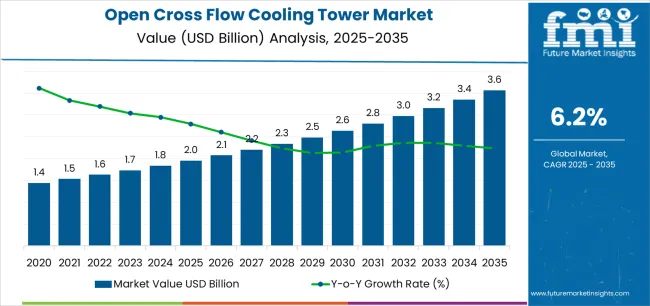
The market encompasses various construction materials, capacity ranges, and specialized configurations tailored for specific industrial cooling applications. Modern open cross flow cooling towers incorporate advanced fill media technologies, improved drift eliminator systems, and enhanced fan configurations that can deliver consistent performance across diverse environmental conditions while maintaining optimal water conservation practices. The integration of variable frequency drives, automated control systems, and remote monitoring capabilities has further enhanced the operational efficiency of these cooling systems among industrial users seeking reliable thermal management and operational cost optimization.
Market dynamics are significantly influenced by stringent environmental regulations, particularly regarding water usage optimization, thermal discharge management, and air quality compliance in industrial and commercial cooling applications where environmental impact mitigation and operational efficiency are critical considerations. The industrial sector's increasing focus on process optimization, energy efficiency, and operational reliability has created substantial demand for high-performance cooling tower solutions in manufacturing facilities, power generation plants, and process cooling systems. Additionally, the growing trend toward integrated thermal management systems and smart cooling technologies has amplified the need for intelligent cooling tower systems capable of integration with advanced building management systems and industrial control networks.
Consumer purchasing patterns show a marked preference for modular cooling tower systems that combine durable construction materials with flexible capacity options, multiple configuration possibilities, and comprehensive performance certification for diverse industrial and commercial applications. The market has witnessed significant technological advancement in fill media design, fan blade optimization, and water treatment integration systems, making these devices more suitable for extreme weather conditions, high-capacity applications, and environmentally sensitive installations.
Between 2025 and 2030, the market is projected to expand from USD 1,952.8 million to USD 2,638.0 million, resulting in a value increase of USD 685.2 million, which represents 42.6% of the total forecast growth for the decade. This phase of development will be shaped by increasing industrial capacity expansion, rising demand for energy-efficient cooling solutions, and growing availability of advanced heat transfer technologies across manufacturing facilities and commercial building applications.
Between 2030 and 2035, the market is forecast to grow from USD 2,638.0 million to USD 3,563.6 million, adding another USD 925.6 million, which constitutes 57.4% of the overall ten-year expansion. This period is expected to be characterized by the advancement of IoT-enabled cooling tower monitoring systems, the development of energy-efficient fan technologies for large-scale applications, and the expansion of intelligent thermal management networks across diverse industrial and commercial cooling applications. The growing focus on environmental compliance and operational optimization will drive demand for advanced cooling tower varieties with enhanced water conservation capabilities, improved energy efficiency characteristics, and superior automated control performance profiles.
Between 2020 and 2024, the market experienced steady growth, driven by increasing industrial development investments and growing recognition of cross flow cooling technology's superior performance in high-capacity applications following extensive industry adoption campaigns. The market developed as manufacturers recognized the advantages of open cross flow cooling towers over alternative cooling methods in large-scale industrial applications and began seeking specialized solutions designed for specific thermal management requirements. Technological advancement in fill media materials and fan optimization technologies began emphasizing the critical importance of maintaining cooling efficiency while enhancing energy conservation and improving operational reliability across diverse industrial cooling applications.
| Metric | Value |
|---|---|
| Estimated Value in (2025E) | USD 1,952.8 million |
| Forecast Value in (2035F) | USD 3,563.6 million |
| Forecast CAGR (2025 to 2035) | 6.2% |
From 2030 to 2035, the market is forecast to grow from USD 2,638.0 million to USD 3,563.6 million, adding another USD 925.6 million, which constitutes 57.4% of the overall ten-year expansion. This period is expected to be characterized by the advancement of artificial intelligence integration in cooling tower monitoring systems, the integration of predictive diagnostics for optimal maintenance scheduling, and the development of specialized tower configurations for high-efficiency industrial applications. The growing focus on operational efficiency and environmental compliance will drive demand for premium varieties with enhanced thermal performance capabilities, improved water management options, and superior automated monitoring characteristics.
Between 2020 and 2024, the market experienced robust growth, driven by increasing awareness of energy-related operational costs and growing recognition of specialized cooling systems' effectiveness in supporting reliable industrial operations across manufacturing facilities and power generation applications. The market developed as users recognized the potential for open cross flow cooling towers to deliver operational advantages while meeting modern requirements for efficient thermal management and reliable cooling performance. Technological advancement in heat transfer optimization and material durability development began emphasizing the critical importance of maintaining cooling efficiency while extending operational life and improving user satisfaction across diverse industrial cooling applications.
Market expansion is being supported by the increasing global focus on industrial energy efficiency and the corresponding shift toward high-performance cooling systems that can provide superior thermal management characteristics while meeting user requirements for reliable cooling operation and cost-effective maintenance solutions. Modern industrial users are increasingly focused on incorporating cooling systems that can enhance operational reliability while satisfying demands for consistent, precisely controlled thermal management and optimized energy consumption practices. Open cross flow cooling towers' proven ability to deliver heat transfer excellence, energy efficiency benefits, and diverse application possibilities makes them essential components for energy-focused manufacturers and efficiency-focused industrial professionals.
The growing focus on environmental compliance and industrial equipment efficiency is driving demand for high-performance cooling tower systems that can support distinctive operational outcomes and comprehensive thermal management across manufacturing processes, power generation applications, and premium industrial installations. User preference for cooling solutions that combine functional excellence with environmental responsibility is creating opportunities for innovative implementations in both traditional and emerging industrial cooling applications. The rising influence of smart building technologies and advanced monitoring systems is also contributing to increased adoption of intelligent cooling tower solutions that can provide authentic operational benefits and reliable performance monitoring characteristics.
The market is segmented by type, application, capacity range, construction material, and region. By type, the market is divided into fiberglass, carbon steel, stainless steel tower, and others. Based on application, the market is categorized into electricity, chemical industry, metallurgy, air conditioning system, and others. By capacity range, the market includes small capacity, medium capacity, and large capacity categories. By construction material, the market encompasses concrete, steel, fiberglass reinforced plastic, and hybrid materials. Regionally, the market is divided into North America, Europe, Asia Pacific, Latin America, Middle East & Africa, and other regions.
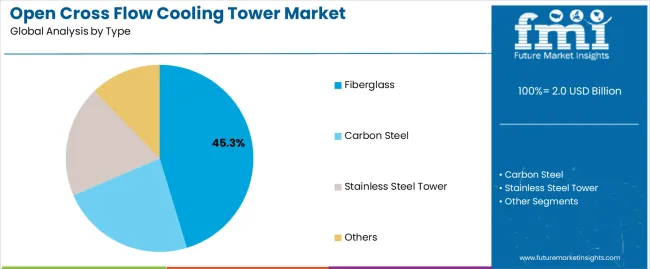
The fiberglass segment is projected to account for 45.3% of the market in 2025, reaffirming its position as the leading type category. Industrial users and facility managers increasingly utilize fiberglass systems for their superior corrosion resistance characteristics, established durability standards, and essential functionality in diverse industrial cooling applications across multiple sectors. Fiberglass towers' proven performance characteristics and established cost-effectiveness directly address user requirements for reliable cooling performance and optimal operational longevity in industrial and commercial applications.
This type segment forms the foundation of modern cooling tower performance patterns, as it represents the construction material with the greatest application versatility and established compatibility across multiple industrial cooling systems. Industrial investments in advanced composite technology and performance optimization continue to strengthen adoption among efficiency-focused users. With manufacturers prioritizing operational consistency and maintenance reliability, fiberglass systems align with both durability objectives and performance requirements, making them the central component of comprehensive thermal management strategies.
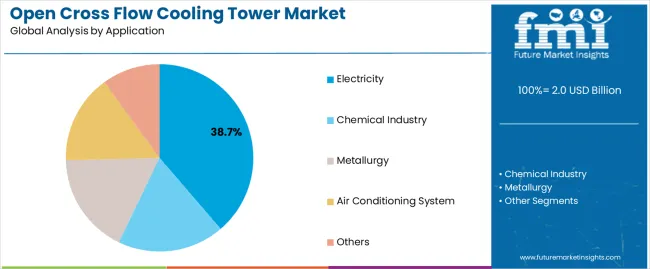
Electricity is projected to represent 38.7% of the market in 2025, underscoring its critical role as the primary application for efficiency-focused users seeking superior cooling benefits and enhanced power generation process management credentials. Power plant operators and utility managers prefer electricity applications for their established operational requirements, proven performance demand, and ability to maintain exceptional cooling precision while supporting versatile capacity coverage during diverse power generation activities. Positioned as essential applications for efficiency-focused power producers, electricity offerings provide both operational excellence and process optimization advantages.
The segment is supported by continuous improvement in power generation technology and the widespread availability of established industry standards that enable performance assurance and premium positioning at the utility level. Electricity users are optimizing cooling tower selections to support plant-specific applications and comprehensive power generation strategies. As energy efficiency technology continues to advance and power producers seek efficient cooling methods, electricity applications will continue to drive market growth while supporting operational efficiency and thermal management strategies.
The open cross flow cooling tower market is advancing rapidly due to increasing industrial capacity expansion and growing need for energy-efficient cooling solutions that emphasize superior thermal performance across manufacturing segments and power generation applications. The market faces challenges, including competition from alternative cooling technologies, installation complexity considerations, and initial investment cost factors affecting adoption rates. Innovation in heat transfer enhancement and advanced materials continues to influence market development and expansion patterns.
The growing adoption of open cross flow cooling towers with building automation connectivity and industrial IoT integration is enabling users to develop cooling strategies that provide distinctive monitoring benefits while commanding automated operation and enhanced real-time performance analysis characteristics. Smart building applications provide superior operational consistency while allowing more sophisticated energy optimization features across various commercial categories. Users are increasingly recognizing the operational advantages of intelligent cooling positioning for comprehensive thermal management outcomes and technology-integrated facility management.
Modern open cross flow cooling tower manufacturers are incorporating advanced efficiency sensors, real-time performance monitoring capabilities, and environmental compliance systems to enhance operational precision, improve equipment reliability effectiveness, and meet industrial demands for intelligent cooling solutions. These systems improve operational effectiveness while enabling new applications, including continuous efficiency monitoring programs and automated environmental protocols. Advanced efficiency integration also allows users to support proactive compliance positioning and performance assurance beyond traditional cooling operation requirements.
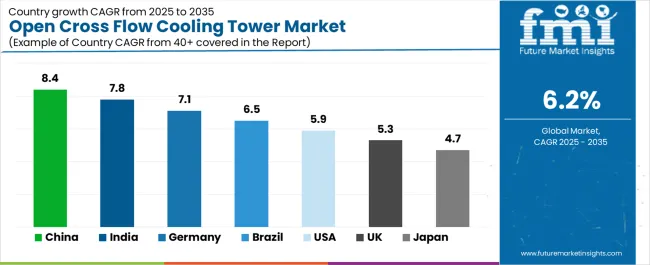
| Country | CAGR (2025-2035) |
|---|---|
| China | 8.4% |
| India | 7.8% |
| Germany | 7.1% |
| Brazil | 6.5% |
| USA | 5.9% |
| UK | 5.3% |
| Japan | 4.7% |
The market is experiencing robust growth globally, with China leading at a 8.4% CAGR through 2035, driven by the expanding industrial sector, growing power generation requirements, and increasing adoption of advanced cooling systems. India follows at 7.8%, supported by rising industrialization, expanding manufacturing industry, and growing acceptance of energy-efficient technologies. Germany shows growth at 7.1%, emphasizing established engineering standards and comprehensive industrial development. Brazil records 6.5%, focusing on industrial modernization and manufacturing capacity growth. The USA demonstrates 5.9% growth, prioritizing advanced cooling technologies and operational optimization.
The report covers an in-depth analysis of 40+ countries, top-performing countries are highlighted below.
China is projected to exhibit exceptional growth with a CAGR of 8.4% through 2035, driven by the country's rapidly expanding industrial sector, favorable government policies toward manufacturing modernization, and initiatives promoting energy-efficient technologies across major industrial regions. China's position as a global manufacturing hub and increasing focus on thermal management systems are creating substantial demand for high-quality open cross flow cooling towers in both domestic and export markets. Major industrial equipment companies and cooling system distributors are establishing comprehensive cooling capabilities to serve growing demand and emerging efficiency opportunities.
India is expanding at a CAGR of 7.8%, supported by rising industrialization investment, growing efficiency consciousness, and expanding equipment distributor capabilities. The country's developing industrial infrastructure and increasing investment in manufacturing technologies are driving demand for cooling towers across both traditional and modern industrial applications. International cooling companies and domestic distributors are establishing comprehensive operational networks to address growing market demand for thermal management devices and efficient cooling solutions.
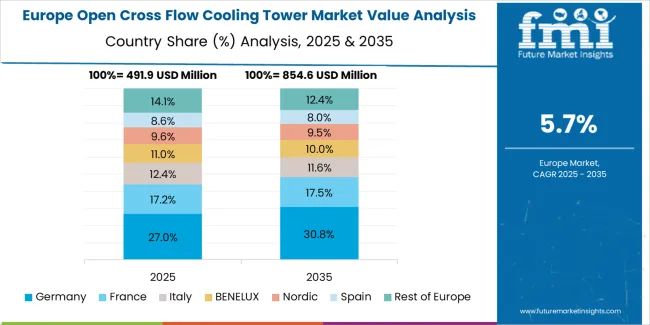
Germany is projected to grow at a CAGR of 7.1% through 2035, supported by the country's mature engineering standards, established industrial regulations, and leadership in precision manufacturing technology. Germany's sophisticated industrial standards and strong support for advanced cooling systems are creating steady demand for both traditional and innovative cooling tower varieties. Leading cooling manufacturers and specialty distributors are establishing comprehensive operational strategies to serve both domestic markets and growing export opportunities.
Brazil is projected to grow at a CAGR of 6.5% through 2035, driven by the country's focus on industrial development, manufacturing modernization growth, and growing cooling distributor capabilities. Brazilian industrial users and manufacturing facilities consistently seek efficiency-focused equipment that enhances operational performance and supports modernization excellence for both traditional and modern industrial applications. The country's position as a Latin American industrial leader continues to drive innovation in specialized cooling applications and manufacturing efficiency standards.
The USA is projected to grow at a CAGR of 5.9% through 2035, supported by the country's focus on manufacturing technology advancement, industrial efficiency optimization, and advanced cooling system integration requiring efficient thermal management solutions. American industrial users and efficiency-focused facilities prioritize performance reliability and operational precision, making specialized open cross flow cooling towers essential components for both traditional and modern industrial applications. The country's comprehensive manufacturing technology leadership and advancing efficiency patterns support continued market expansion.
The UK is projected to grow at a CAGR of 5.3% through 2035, supported by established industrial standards, mature cooling markets, and focus on operational reliability across manufacturing and commercial sectors. British industrial users and cooling professionals prioritize quality performance and operational consistency, creating steady demand for premium cooling solutions. The country's comprehensive market maturity and established industrial practices support continued development in specialized applications.
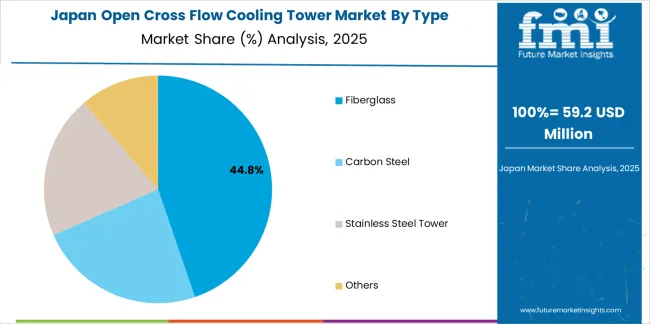
Japan is projected to grow at a CAGR of 4.7% through 2035, supported by the country's focus on precision manufacturing, operational excellence, and advanced technology integration requiring efficient cooling solutions. Japanese industrial users and efficiency-focused facilities prioritize technical performance and manufacturing precision, making specialized open cross flow cooling towers essential components for both traditional and modern industrial applications. The country's comprehensive manufacturing leadership and advancing precision patterns support continued market expansion.
What is the market split by country in Europe?
The Europe open cross flow cooling tower market is projected to grow from USD 425.7 million in 2025 to USD 718.4 million by 2035, recording a CAGR of 5.4% over the forecast period. Germany leads the region with a 41.8% share in 2025, moderating slightly to 41.2% by 2035, supported by its strong engineering traditions and demand for premium, precision-manufactured cooling solutions. The United Kingdom follows with 22.4% in 2025, easing to 21.9% by 2035, driven by a mature industrial cooling market and focus on operational reliability and quality performance.
France accounts for 15.2% in 2025, rising to 15.8% by 2035, reflecting steady adoption of industrial cooling technologies and process optimization. Italy holds 9.7% in 2025, expanding to 10.4% by 2035 as manufacturing modernization and specialty cooling applications grow. Spain contributes 6.1% in 2025, growing to 6.5% by 2035, supported by expanding industrial development and cooling awareness modernization. The Nordic countries rise from 3.4% in 2025 to 3.7% by 2035 on the back of strong engineering consciousness and advanced manufacturing methodologies. BENELUX remains at 1.4% share across both 2025 and 2035, reflecting mature, efficiency-focused industrial markets.
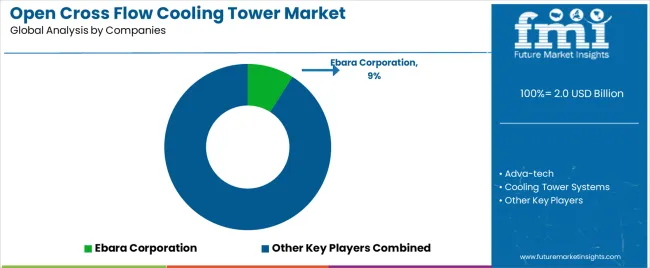
The market is characterized by competition among established industrial equipment manufacturers, specialized cooling companies, and integrated thermal management providers. Companies are investing in advanced heat transfer technologies, specialized materials engineering, product innovation capabilities, and comprehensive distribution networks to deliver consistent, high-quality, and reliable cooling tower systems. Innovation in fill media optimization, fan technology advancement, and efficiency-focused product development is central to strengthening market position and customer satisfaction.
Ebara Corporation leads the market with 9% share with a strong focus on cooling technology innovation and comprehensive thermal management solutions, offering industrial and commercial systems with focus on performance excellence and engineering heritage. Adva-tech provides integrated cooling automation with a focus on industrial market applications and precision thermal networks. Cooling Tower Systems delivers comprehensive tower technology solutions with a focus on industrial positioning and operational efficiency. Classik Cooling Towers specializes in comprehensive cooling systems with a focus on industrial applications. Composite Cooling Solutions focuses on comprehensive cooling instrumentation with advanced design and premium positioning capabilities.
The success of open cross flow cooling towers in meeting industrial cooling demands, manufacturing efficiency requirements, and operational integration will not only enhance industrial performance outcomes but also strengthen global thermal management manufacturing capabilities. It will consolidate emerging regions' positions as hubs for efficient industrial cooling production and align advanced economies with comprehensive cooling systems. This calls for a concerted effort by all stakeholders -- governments, industry bodies, manufacturers, distributors, and investors. Each can be a crucial enabler in preparing the market for its next phase of growth.
| Items | Values |
|---|---|
| Quantitative Units (2025) | USD 1,952.8 million |
| Type | Fiberglass, Carbon Steel, Stainless Steel Tower, Others |
| Application | Electricity, Chemical Industry, Metallurgy, Air Conditioning System, Others |
| Capacity Range | Small Capacity, Medium Capacity, Large Capacity |
| Construction Material | Concrete, Steel, Fiberglass Reinforced Plastic, Hybrid Materials |
| Regions Covered | North America, Europe, Asia Pacific, Latin America, Middle East & Africa, Other Regions |
| Countries Covered | China, India, Germany, Brazil, United States, United Kingdom, Japan, and 40+ countries |
| Key Companies Profiled | Ebara Corporation, Adva-tech, Cooling Tower Systems, Classik Cooling Towers, Composite Cooling Solutions, and other leading open cross flow cooling tower companies |
| Additional Attributes | Dollar sales by type, application, capacity range, construction material, and region; regional demand trends, competitive landscape, technological advancements in cooling engineering, heat transfer optimization initiatives, efficiency enhancement programs, and premium product development strategies |
The global open cross flow cooling tower market is estimated to be valued at USD 2.0 billion in 2025.
The market size for the open cross flow cooling tower market is projected to reach USD 3.6 billion by 2035.
The open cross flow cooling tower market is expected to grow at a 6.2% CAGR between 2025 and 2035.
The key product types in open cross flow cooling tower market are fiberglass, carbon steel, stainless steel tower and others.
In terms of application, electricity segment to command 38.7% share in the open cross flow cooling tower market in 2025.






Full Research Suite comprises of:
Market outlook & trends analysis
Interviews & case studies
Strategic recommendations
Vendor profiles & capabilities analysis
5-year forecasts
8 regions and 60+ country-level data splits
Market segment data splits
12 months of continuous data updates
DELIVERED AS:
PDF EXCEL ONLINE
Open Source Service Market Size and Share Forecast Outlook 2025 to 2035
Open Radio Access Network Market and Forecast Outlook 2025 to 2035
Open Cycle Aeroderivative Gas Turbine Market Size and Share Forecast Outlook 2025 to 2035
Open Transition Transfer Switch Market Size and Share Forecast Outlook 2025 to 2035
Open API Market Size and Share Forecast Outlook 2025 to 2035
Open Mouth Sacks Market Size and Share Forecast Outlook 2025 to 2035
Open Banking Market Analysis - Size, Share, and Forecast 2025 to 2035
Open Source Intelligence Market Trends – Growth & Forecast 2025 to 2035
Open Air Merchandizers and Accessories Market - Industry Innovations & Demand 2025 to 2035
Open Top Cartons Market
Open Gear Lubricants Market
Opening Trim Weatherstrips Market
Neopentyl Polyhydric Alcohol Market Size and Share Forecast Outlook 2025 to 2035
Global Neopentyl Glycol (NPG) Market Analysis – Size, Share & Forecast 2025–2035
Lycopene Food Colors Market Growth Share Trends 2025 to 2035
Lycopene Market
Cyclopentanone Market Size and Share Forecast Outlook 2025 to 2035
Can Opener Market Analysis – Growth & Industry Outlook 2025 to 2035
Easy Open Packaging Market Size and Share Forecast Outlook 2025 to 2035
Twist Open - Twist Close Caps Market Size and Share Forecast Outlook 2025 to 2035

Thank you!
You will receive an email from our Business Development Manager. Please be sure to check your SPAM/JUNK folder too.
Chat With
MaRIA